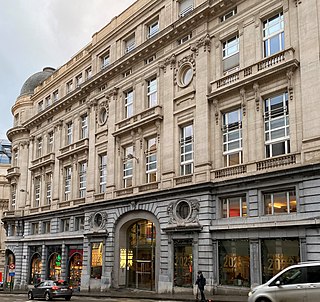
BNP Paribas is a French multinational universal bank and financial services holding company headquartered in Paris. It was founded in 2000 from the merger of two of France's foremost financial institutions, Banque Nationale de Paris (BNP) and Paribas. It also incorporates many other major institutions through successive acquisitions, including Fortis Bank in Belgium, Direkt Anlage Bank in Germany, Banca Nazionale del Lavoro in Italy, Banque Générale du Luxembourg in Luxembourg, and Türk Ekonomi Bankası in Turkey. The group has also been present in the United States through its subsidiaries Bank of the West until 2023 and First Hawaiian Bank until 2019. With 190,000 employees, the bank is organized into three major business areas: Commercial, Personal Banking & Services (CPBS); Investment & Protection Services (IPS); and Corporate & Institutional Banking (CIB).

Banque Nationale de Paris was a major French bank. It was formed in 1966 through the merger of Comptoir national d'escompte de Paris and Banque nationale pour le commerce et l'industrie. In 1999, it merged with Paribas to form BNP Paribas.

The Banque Belge pour l'Étranger was a Belgian bank that channeled many international banking operations of its controlling shareholder the Société Générale de Belgique (SGB) in the first half of the 20th century. It was originally established by the SGB in 1902 in Brussels as the Banque Sino-Belge, at the request of King Leopold II of Belgium.

Émile Pereire and his brother Isaac Pereire were major figures in the development of France's finance and infrastructure during the Second French Empire. The Pereire brothers challenged the dominance of the Rothschilds in continental European finance, known at the time as haute finance. Their attempt was temporarily successful, and even though it collapsed in the late 1860s, it contributed to a more developed and vibrant economic landscape. Like the Rothschilds, the Pereires were Jews, but unlike them, they were Sephardi of Portuguese origin.

The Banque Marocaine pour le Commerce et l'Industrie is a bank in Morocco, headquartered in Casablanca. It is majority-owned subsidiary of Paris-based BNP Paribas (BNPP), and originates from the Moroccan operations of a predecessor of BNPP, the Banque Nationale pour le Commerce et l'Industrie (BNCI).

The Crédit Industriel et Commercial is a bank and financial services group in France, founded in 1859. It has been majority owned by Crédit Mutuel, one of the country's top five banking groups, since 1998, and fully owned since 2017.
Banque du Caire is a bank in Egypt, founded in 1952. It has a variety of services and products across the corporate and retail segments.
The Banque de Paris et des Pays-Bas, generally referred to from 1982 as Paribas, was a French investment bank based in Paris. In May 2000, it merged with the Banque Nationale de Paris to form BNP Paribas.

The Comptoir national d'escompte de Paris (CNEP), from 1854 to 1889 Comptoir d'escompte de Paris (CEP), was a major French bank active from 1848 to 1966.

The Banque nationale pour le commerce et l'industrie was a major French bank, active from 1932 to 1966 when it merged with Comptoir national d'escompte de Paris to form Banque Nationale de Paris (BNP). It was itself the successor of the Comptoir d'Escompte de Mulhouse, a bank founded in 1848 under the Second French Republic that had become German following the Franco-Prussian War, and its French subsidiary formed in 1913, the Banque Nationale de Crédit.

Louis-Raphaël Bischoffsheim was a German international banker and a member of the prominent Bischoffsheim family.

The Banque de l'Union Parisienne was a French investment bank, created in 1904 and merged into Crédit du Nord in 1973.
Henry Bizot (1901–1990) was a French banker, and the first chairman of Banque Nationale de Paris.

The Banque Française pour le Commerce et l'Industrie was a significant bank in France, formed in 1901 from two predecessor entities, the Banque Franco-Égyptienne and the Banque Française d'Afrique du Sud. It was purchased in 1922 by the Banque Nationale de Crédit, a predecessor entity of BNP Paribas.

Pierre Armand Donon was a French banker. During his heyday around 1860 he was known as the banking partner of Charles, duc de Morny, a key figure of the Second French Empire, with whom he partnered for the early development of Deauville.

The Société des Dépôts et Comptes Courants (SDCC) was a French bank, created in 1863 and liquidated in 1891. Its business was subsequently taken over by the recently restructured Comptoir d'Escompte de Paris.

The Société Belge de Banque was a medium-sized Belgian bank, established in 1901 as the Banque Générale Belge, renamed in 1932, and eventually merged in 1965 into the Société Générale de Banque.

The Bank of Savoy was a bank of issue of the Kingdom of Sardinia, established in 1851 and based in Annecy and Chambéry. As a consequence of France's annexation of the former Duchy of Savoy under the Treaty of Turin (1860), the Bank of Savoy ceded its money-issuance role to the Bank of France in 1865.

The Banque Internationale pour le Commerce et l'Industrie (BICI) was a network of banks in sub-Saharan Africa created from 1962 onwards by Paris-based Banque Nationale pour le Commerce et l'Industrie (BNCI). Following successive mergers it was inherited by BNCI's successors the Banque Nationale de Paris then BNP Paribas. BNP Paribas sold most of the BICI network in the early 2020s.

The banques départementales were joint-stock banks of issue that were created in major secondary trade hubs of France in the early 19th century, echoing the role that the Bank of France played in and around Paris. They were key components of the French financial system during the Bourbon Restoration and July Monarchy.
















